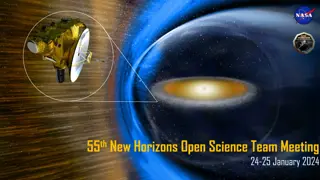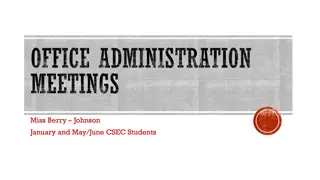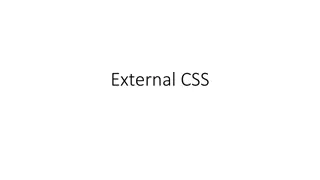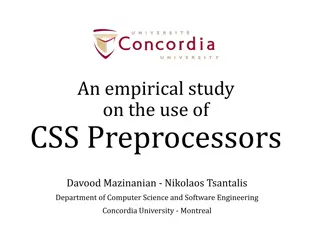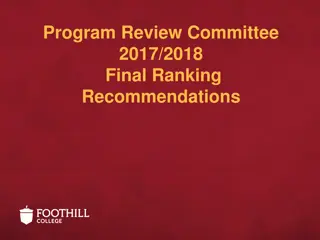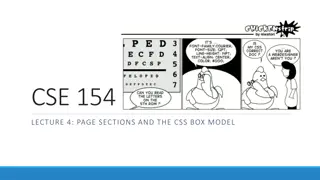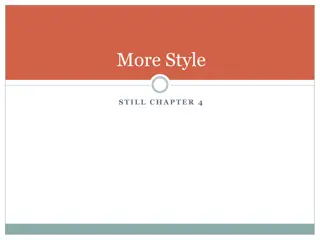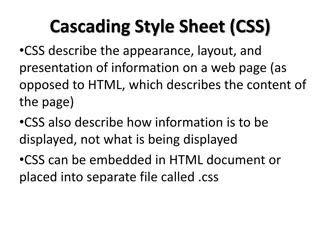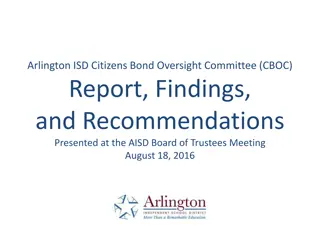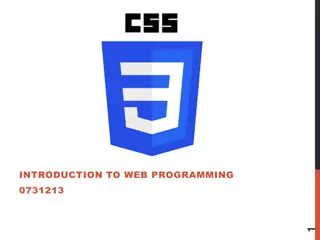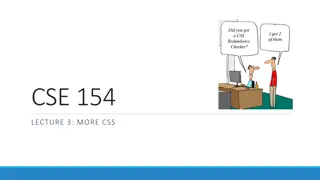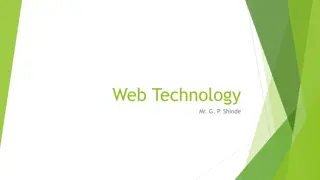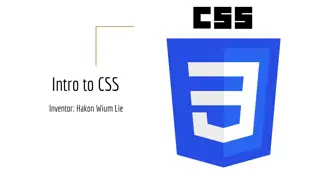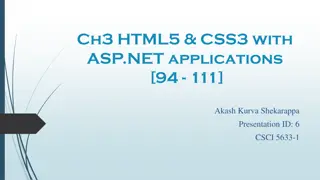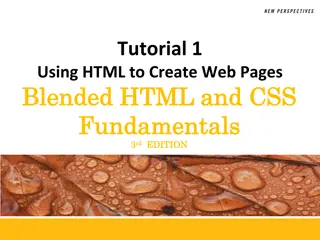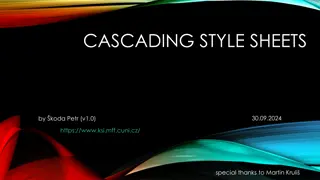Recommendations and Progress Report from Review Committee Meetings - CSS 55th Meeting
The 55th meeting of the Review Committee focused on ensuring safety standards are up-to-date for emerging challenges. Recommendations include structuring IAEA safety standards, obtaining feedback systematically, and monitoring progress through a dashboard. Implementation progress involves knowledge preservation and drafting safety standards. Dashboard visuals highlight monitoring mechanisms. The report emphasizes adaptation to new technological and environmental challenges for safety standards.
Download Presentation

Please find below an Image/Link to download the presentation.
The content on the website is provided AS IS for your information and personal use only. It may not be sold, licensed, or shared on other websites without obtaining consent from the author. Download presentation by click this link. If you encounter any issues during the download, it is possible that the publisher has removed the file from their server.
E N D
Presentation Transcript
Review Committee meetings CSS End of term report CSS 55th meeting Dominique Delattre Scientific Secretary of the CSS
Recommendations from the 7th end of term report (1/3) Ensure that safety standards remain fit for purpose to meet upcoming and emerging challenges that have the potential to impact safety, including such matters as artificial intelligence, climate change and advanced reactor designs. In particular the following actions are recommended: Prepare the long-term structure and plan for the IAEA safety standards, Establish a dynamic portal for the ongoing work of the CSS working group and the CSS members, and Develop a suite of dedicated sessions at the CSS meetings on the history and current structure of the IAEA safety standards, the current SPESS A strategy and criteria, their evaluation, the input from environmental scans, along with input from the Safety Standards Committees. 2
Recommendations from the 7th end of term report (2/3) Establish a more systematic mechanism to obtain feedback from the MS on the use of the IAEA safety standards, feedback on the safety standards from peer review and assistance missions and associated databases, including NSS-OUI for collecting these in a systematic manner. Evaluate potential flexibilities and agilities of the SPESS B process. This includes identifying opportunities for adjusting the schedule of meetings of the Committees and the CSS and the use of virtual intersessional meetings. Some of the recommendations that were established for the 7th term would also remain for the eight term. For example, the publications on how to address the safety security interfaces and the promotion of revision of safety standards by batch. 3
Recommendations from the 7th end of term report (3/3) Already implemented: Ensure knowledge preservation while moving to a new term of the Safety Standards Committees and the CSS, including knowledge transfer for new Chairpersons and Scientific Secretaries. In progress: Establish a dashboard to monitor the progress of the drafting, review, approval and publication of safety standards. 4
Dashboard (3/3) Dashboard for Draft Safety Standards (iaea.org) 7
Summary of the meeting (1/5) All Review Committees presented their recommendations for their new term in detail. Examining the recommendations from all Review Committees, the Chairs and the Secretariat identified cross-cutting topics, as well as areas of work where more than one Committees are involved. These can also be considered by the CSS when drafting its recommendations for its eighth term. 9
Summary of the meeting (2/5) The Chairs and the Secretariat discussed the format of the Member States presentations at the meetings of the Review Committees, and how these presentations can be used to collect feedback on the use of safety standards. All Chairs shared their experience on the usual practices for Member States presentations from their Committees. 10
Summary of the meeting (3/5) The Group discussed the option to have topical sessions focussing on specific aspects of the national application of safety standards. However, the need was identified to encourage more Member States to deliver presentations, and to have a more varied presence of States (big/small, embarking/advanced) to reflect the current state of application of the safety standards. The Secretariat will work on developing a guideline template for the Member States presentations using the NUSSC template as a starting point. The intent is to use this template at the Review Committee meetings in Q4 2024. 11
Summary of the meeting (4/5) The Secretariat presented a proposal on the sequencing of meetings of the Committees and the CSS so as not to introduce unnecessary delays in the review and approval of DPPs and drafts. The proposal was as follows: Committees meetings in June (preferably the first half), and follow-up CSS meeting beginning of October Committees meetings in November (preferably the second half), and follow-up CSS meeting in March The Chairs agreed with the proposal. Its implementation will start with the meetings planned for 2026 (as all meetings are already planned up to the end of 2025) The Scientific Secretary of the CSS presented an update on actions from previous CSS meeting (as on Day 1 of CSS) 12
Summary of the meeting (5/5) Under any other business, the Chair of EPReSC asked about analysis of the potential implications of GSR Part 7 to GSR Part 3 to improve consistency between GSR Part 3 and GSR Part 7 (including to discuss the dose coefficients). The Chairs of EPReSC and RASSC (and the Scientific Secretaries) agreed to have bilateral discussions and report back to the next meeting of the Chairs. At the initiative of the Chair of the CSS, the Chairs agreed to meet virtually before the next round of the Committee meetings in August/September. The Secretariat will organize the meeting. 13
Cross-cutting elements for all Committees Having joint meetings between the Committees Implementation of the medium term plan Further contribution for the long term structure and plan Addressing new technologies in the safety standards: SMRs, TNPPs, Floating NPPs, Nuclear Propelled Merchant Ships, use of AI Collecting feedback from MS on the use of the IAEA Safety Standards in a more effective manner Feedback from IAEA Peer Review and Advisory Services. Implications on the safety standards Safety-security interfaces. (including consideration for additional joint publications) Review of GSR Part 7 Consideration of how to incorporate dose coefficients for internal and external exposures based on the ICRP 2007 Recommendations into the IAEA Safety Standards 14
Some specific additional potential topical areas with interfaces between some Committees (1/2) RASSC Development of guidance on trade in non-food commodities [interface with NSGC and TRANSSC]. Development of guidance on radiation safety in radionuclide therapies [interface with WASSC and TRANSSC (interface on Denial of Shipment)]. TRANSSC Transport of NORM derivation of exemption values for the transport of NORM [interface with RASSC]. Dual purpose casks [interface with WASSC]. Ageing of transport packages [interface with NUSSC, WASSC and EPReSC]. Revision of A1/A2 Values [interface with RASSC and NSGC 15
Some specific additional potential topical areas with interfaces between some Committees (2/2) WASSC Waste classification, derivation and application of waste acceptance criteria for predisposal management (including storage) and disposal [interface with NUSSC and TRANSSC]. Management of spent fuel and radioactive waste stored for extended periods [interface with NUSSC and TRANSSC]. 16
Participants at the CSS WG meeting Chair: Jussi Heinonen, Finland Jean-Luc Lachaume, France Anil Bekir B lme, T rkiye Rosa Sardella: Switzerland (alternate because the CSS Chair, Marc Kenzelmann is from Switzerland) All Chairpersons of the Review Committee (for the first time) 19
Items discussed at the CSS WG meeting History of the IAEA Safety Standards and the resulting current structure Presentation of SPESS A, including the criteria for the safety requirements and the safety guides Presentations on the input from all the Safety Standards Committees for the long term plan Introduction on the mechanisms in place to analyse in a systematic manner the feedback on safety standards from the peer review and assistance missions. Presentation on IRRS and on OSART. CSS questionnaire preparation Input from International Organizations at the Committees and at the CSS Format for the Member States presentations at the Committees on feedback from the set of safety standards (follow-up to the Chairs meeting on 27 May) 20
Status of endorsed Safety Standards (1/4) Six Safety Standards published since the last CSS meeting in November: DS470: Radiation Safety in the Use of Radiation Sources used in Research and Education, SSG-87 DS508: Design Extension Conditions and the Concept of Practical Elimination in the Design of Nuclear Power Plants, SSG-88 DS522: Evaluation of Seismic Safety for Nuclear Installations, SSG-89 DS523: Development and Application of Level 1 Probabilistic Safety Assessment for Nuclear Power Plants, SSG-3 (Rev. 1). This is the first one with the new design of the cover page. DS512: Borehole Disposal Facilities for Disused Sealed Radioactive Sources, SSG-1 (Rev. 1) DS524: Radiation Protection Aspects of Design for Nuclear Power Plants, SSG- 90 22
Status of endorsed Safety Standards (2/4) 17 Safety Guides published in 2023, like in 2022. This is again the highest rate ever achieved 23
Status of endorsed Safety Standards (3/4) Remaining endorsed Safety Standards to be issued after endorsement: NONE :) 24
Status of endorsed Safety Standards (4/4) Time in number of months from CSS endorsment to Publication Order is according to the date of submission to MS for comments Blue line: individual data - green line: average last 10 25 20 15 10 5 0 25
Overall Status 160 140 120 100 80 60 40 20 0 Project approval Drafting and first review by RCs MS comments Final review by RCs and CSS Establishment and publication Published 26
Induction session 2.1. History of the IAEA Safety Standards 2.2. SPESS A: Strategies and Processes for the Establishment of IAEA Safety Standards (SPESS A) 2.3. SPESS B: Manual for the review process for draft Nuclear Security Series Publications and for the application of the strategies and processes for the establishment of IAEA Safety Standards (SPESS) 2.4. Nuclear Safety and Security Online User Interface (NSS-OUI) 2.5.Information on web sites resources available for the CSS members on the IAEA Safety Standards 27
Presentations of the Review Committees Focused first on general information Highlighted the recommendations for the new term Indicated input from the Committees to the work on the long term structure and plan 28
Drafts and DPPs Draft Safety Guide DS519 on Protection of Workers to Exposure due to Radon endorsed Draft Safety Guide DS525 on Chemistry Programme for Water Cooled Nuclear Power Plants endorsed Draft DPP DS552 for a Safety Guide on Safety Evaluation of Nuclear Installations for External Events Excluding Earthquakes approved Draft DPP DS553 for a Safety Guide on The Safety Case and Safety Assessment for the Predisposal Management of Radioactive Waste, revision of GSG-3 approved Draft DPP DS554 for a Safety Guide on Advisory Material for the IAEA Regulations for the Safe Transport of Radioactive Material (20XX Edition) SSG-26 (Rev. 2), revision of SSG-26 (Rev. 1) approved Endorsement by the CSS of the RASSC conclusion that RS-G-1.10 is superseded by existing safety guides 29
Recommendations for the 8th term (1/2) Ensure that safety standards remain fit for purpose to meet upcoming and emerging challenges that have the potential to impact safety, including such matters as artificial intelligence, climate change and advanced reactor designs: Preparation of the long term structure and plan. Establish a more systematic mechanism to obtain feedback from the MS, cosponsors and observers on the use of the IAEA safety standards*, obtain feedback on the safety standards from peer review and assistance missions and associated databases, including NSS-OUI for collecting these in a systematic manner. * Including feedback on Member States practices on the consideration of socio-economical factors 30
Recommendations for the 8th term (2/2) Organize topical discussions during the eight term to guide the work of the Committees Monitor the implementation of the mid-term plan. Evaluate and implement potential flexibilities and agilities of the SPESS B process. Maintain ongoing recommendations for the 7th term on addressing safety security interfaces and on the promotion of revision of safety standards by amendment and by batch and to develop guidance on the application of the graded approach concept. 31
Report of the CSS WG LTSP Questionnaire to the CSS, to be answered by the CSS members in consultation with their representatives at the Committees: Have you conducted evaluations, either at the national level or within regulatory organizations, of the future operating environment and how potential changes might impact radiation and nuclear safety? Based on your assessments, what are the primary elements or drivers you've identified, and how do you anticipate them affecting safety and security and related regulatory framework? Utilizing the PESTLE (Political, Economic, Social, Technological, Legal, and Environmental) factors, what changes do you anticipate occurring, and what is the anticipated timeframe for these changes? Are there any gap or other issue you would like to raise? 32
MAIN STEPS IN DEVELOPMENT Collecting inputs (2022-2024) Assessment and selection (2025) Preparation of the long-term plan (2026) SPESS A Concept paper Committees assessment of future challenges and opportunities IAEA input from peer review and assistance missions analysis IAEA projects and other plans? Input from other international organizations National inputs through CSS members What should be maintained? What should be enhanced? What new to be included? Drafting of the plan Working in co-operation with all Committees CSS decisions Structure, management process, emerging issues Separation between cross-cutting issues and Committees specific topics 33
New members of the CSS WG LTSP Ramzi Jammal, Canada Donald Urquhart, UK 34
Actions resulting from the 55th CSS meeting (1/2) The Secretariat will assess the use of auxiliary verbs (i.e. must, shall, should, will, would) in the safety standards and report to the next CSS meeting. A topical session on the latest developments in radiation protection will be organized during the next meeting of the CSS to promote a common understanding of the topic and understand the potential implications for the safety standards. The Secretariat will develop a template for the presentations provided by Member States at the meetings of the Review Committees to standardize the collection of input on the application of safety standards at the national level. This template will be used at the Review Committee meetings from Q4 2024 onwards. Revision by batch to improve consistency in the safety standards and promoting cosponsorship to enhance the application of the safety standards to be considered in the next revision of SPESS A by the Secretariat. 35
Actions resulting from the 55th CSS meeting (2/2) The Secretariat will organize the scheduling of the meetings of the Committees and the CSS so as not to introduce unnecessary delays in the review and approval of DPPs and drafts as follows: (a) Committees meetings in June (preferably the first half), and follow-up CSS meeting at the beginning of October, and (b) Committees meeting in November (preferably the second half), and follow-up CSS meeting in March. This will be implemented for scheduling the meetings planned for 2026 onwards. The Secretariat will organize a virtual meeting for the Chair of the CSS and the Chairs of the Review Committees in August/September 2024. The questionnaire for receiving feedback from the CSS members developed by the CSS Working Group will be amended following comments received during the meeting and will be sent to CSS members after this meeting to collect their input. The Secretariat to assess as to whether there are specific situations resulting in some safety requirements publications having a binding character for some Member States. A session on the safety-security interface will be organized during the next meeting of the CSS. 36













